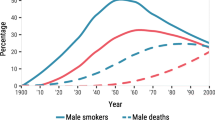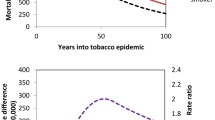Abstract
We examine the variations in the pace of old-age (80+) mortality decline in seven European countries, from 1950 to 1999. Marked variations were found between countries, periods and sexes. While mortality declines were strong in France and England and Wales, modest or no mortality declines were seen in the 1950s and 1960s in the Nordic countries, and since the 1980s in Denmark, the Netherlands and Norway (men only). For non-smoking-related mortality, a high and consistent pace of mortality decline was observed. Mortality decline stagnated among men born between 1890 and 1899, but persisted among women born between 1847 and 1937. The pace of old-age mortality decline correlated with the pace of mortality decline at ages 60–69 among the same cohorts, but only among men and not for non-smoking-related mortality. Smoking, thus, seems more important than other factors originating earlier in life. Our results furthermore indicate substantial future declines in old-age mortality.
Résumé
Nous examinons les variations dans la baisse de la mortalité aux âges élevés (80 ans et plus) dans sept pays européens, de 1950 à 1999. Des variations marquées sont observées entre les pays, entre les périodes et entre les sexes. Alors que la baisse était forte en France et en Angleterre et pays de Galles, elle était modeste ou non existante dans les années 50 et 60 dans les pays du Nord de l’Europe, et depuis les années 80 au Danemark, aux Pays-Bas et en Norvège (pour les hommes seulement). Pour la mortalité non liée au tabac, un rythme soutenu et régulier de baisse de la mortalité est observé. La baisse a subi une stagnation parmi les hommes nés entre 1890 et 1899, mais s’est maintenue parmi les femmes nées entre 1847 et 1937. Le rythme de baisse de la mortalité aux âges élevés était corrélé au rythme de baisse à 60–69 ans dans les mêmes cohortes, mais seulement parmi les hommes et pas pour la mortalité non liée au tabac. Le tabac semble donc jouer un rôle plus important que d’autres facteurs intervenant plus tôt dans la vie. Nos résultats permettent d’anticiper des baisses substantielles de la mortalité aux âges élevés dans le futur.



Similar content being viewed by others
References
Ben-Shlomo, Y., & Kuh, D. (2002). A life course approach to chronic disease epidemiology: Conceptual models, empirical challenges and interdisciplinary perspectives. International Journal of Epidemiology, 31, 285–293.
Bongaarts, J. (2005). Long-range trends in adult mortality: Models and projection methods. Demography, 42, 23–49.
Caselli, G. (1996). Future longevity among the elderly. In G. Caselli & A. Lopez (Eds.), Health and mortality among elderly populations (pp. 235–265). Oxford: Clarendon Press.
Caselli, G., & Vallin, J. (1990). Mortality and population ageing. European Journal of Population/Revue Europeenne de Demographie, 6, 1–25.
Condran, A. G., Himes, C. L., & Preston, S.H. (1991), Old-age mortality patterns in low-mortality countries: An evaluation of population and death data at advanced ages, 1950 to the present. Population Bulletin of the United Nations, 30, 23–60.
Cooper, R., Cutler, J., Desvigne-Nickens, P., Fortmann, S. P., Friedman, L., Havlik, R., Hogelin, G., Marler, J., McGovern, P., Morosco, G., Mosca, L., Pearson, T., Stamler, J., Stryer, D., & Thom, T. (2000). Trends and disparities in coronary heart disease, stroke, and other cardiovascular diseases in the United States: Findings of the national conference on cardiovascular disease prevention. Circulation, 102, 3137–3147.
Ezzati, M., & Lopez, A. D. (2003). Measuring the accumulated hazards of smoking: Global and regional estimates for 2000. Tobacco Control, 12, 79–85.
Fries, J. F. (1980). Aging, natural death, and the compression of morbidity. New England Journal of Medicine, 303, 130–135.
Galobardes, B., Lynch, J. W., & Davey Smith, G. (2004). Childhood socioeconomic circumstances and cause-specific mortality in adulthood: Systematic review and interpretation. Epidemiologic Reviews, 26, 7–21.
Grundy, E. (1997). Demography and gerontology: Mortality trends among the oldest old. Ageing and Society, 17, 713–725.
Janssen, F. (2005). Determinants of trends in old-age mortality. Comparative studies among seven European countries over the period 1950 to 1999. Rotterdam: Erasmus MC, University Medical Center Rotterdam.
Janssen, F., & Kunst, A. E. (2005a). Cohort patterns in mortality trends among the elderly in seven European countries, 1950–99. International Journal of Epidemiology, 34, 1149–1159.
Janssen, F., Mackenbach, J. P., & Kunst, A. E. (2004). Trends in old-age mortality in seven European countries, 1950–1999. Journal of Clinical Epidemiology, 57, 203–216.
Janssen, F., Nusselder, W. J., Looman, C. W. N., Mackenbach, J. P., & Kunst, A. E. (2003). Stagnation in mortality decline among elders in The Netherlands. The Gerontologist, 43, 722–734.
Janssen, F., Peeters, A., Mackenbach, J. P., & Kunst, A. E. (2005b). Relation between trends in late middle-age mortality and trends in old age mortality - is there evidence for mortality selection? Journal of Epidemiology and Community Health, 59, 775–781.
Kannisto, V. (1994). Development of oldest-old mortality, 1950–1990: Evidence from 28 developed countries. Odense, Denmark: Odense University Press.
Kannisto, V., Lauritsen, J., Thatcher, A. R., & Vaupel, J. W. (1994). Reductions in mortality at advanced ages: Several decades of evidence from 27 countries. Population and Development Review, 20, 793–810.
Kesteloot, H., Sans, S., & Kromhout, D. (2002). Evolution of all-causes and cardiovascular mortality in the age-group 75–84 years in Europe during the period 1970–1996; a comparison with worldwide changes. European Heart Journal, 23, 384–398.
Kivela, S. L. (1985). Changes in mortality among the elderly Finnish population 1951–1979. Social Science and Medicine, 21, 799–805.
Kuh, D., & Ben-Shlomo, Y. (1997). A life course approach to chronic disease epidemiology. Oxford: Oxford University Press.
Kuulasmaa, K., Tunstall-Pedoe, H., Dobson, A., Fortmann, S., Sans, S., Tolonen, H., Evans, A., Ferrario, M., & Tuomilehto, J. (2000). Estimation of contribution of changes in classic risk factors to trends in coronary-event rates across the WHO MONICA Project populations. The Lancet, 355, 675–687.
Lopez, A. D. (1995). The lung cancer epidemic in developed countries. In A. D. Lopez, G. Caselli & T. Valkonen (Eds.), Adult mortality in developed countries from description to explanation (pp. 111–134). Oxford, England: Clarendon Press.
Lopez, A. D., Collishaw, N. E., & Piha, T. (1994). A descriptive model of the cigarette epidemic in developed countries. Tobacco Control, 3, 242–247.
Mackenbach, J. P., Looman, C. W., & Kunst, A. E. (1989). Geographic variation in the onset of decline of male ischemic heart disease mortality in The Netherlands. American Journal of Public Health, 79, 1621–1627.
Mackenbach, J. P., Huisman, M., Andersen, O., Bopp, M., Borgan, J. K., Borrell, C., Costa, G., Deboosere, P., Donkin, A., Gadeyne, S., Minder, C., Regidor, E., Spadea, T., Valkonen, T., & Kunst, A. E. (2004). Inequalities in lung cancer mortality by the educational level in 10 European populations. European Journal of Cancer, 40, 126–135.
Manton, K. G., & Stallard, E. (1981). Methods for evaluating the heterogeneity of aging processes in human populations using vital statistics data: Explaining the black/white crossover by a model of mortality selection. Human Biology, 53, 47–67.
Manton, K. G., Stallard, E., & Tolley, H. D. (1991). Limits to human life expectancy: Evidence, prospects, and implications. Population and Development Review, 17, 603–637.
Martelin, T. (1987). Trends in elderly mortality in the Nordic countries. Comprehensive Gerontology [C], 1, 39–48.
McNeil, D. R., Trussell, T. J., & Turner, J. C. (1977). Spline interpolation of demographic data. Demography, 14, 245–252.
Myers, G. C. (1996). Comparative mortality trends among older persons in developed countries. Oxford: Clarendon Press.
Nusselder, W. J., & Mackenbach, J. P. (2000). Lack of improvement of life expectancy at advanced ages in The Netherlands. International Journal of Epidemiology, 29, 140–148.
Oeppen, J., & Vaupel, J. W. (2002). Demography. Broken limits to life expectancy. Science, 296, 1029–1031.
Olshansky, S. J. (1988). On forecasting mortality. The Milbank Quarterly, 66, 482–530.
Olshansky, S. J., & Ault, A. B. (1986). The fourth stage of the epidemiologic transition: The age of delayed degenerative diseases. The Milbank Quarterly, 64, 355–391.
Olshansky, S. J., Carnes, B. A., & Cassel, C. (1990). In search of Methuselah: Estimating the upper limits of human longevity. Science, 250, 634–640.
Olshansky, S. J., Carnes, B. A., & Desesquelles, A. (2001). Demography. Prospects for human longevity Science, 291, 1491–1492.
Omran, A. R. (1971). The epidemiologic transition. A theory of the epidemiology of population change. The Milbank Memorial Fund Quarterly, 49, 509–538.
Omran, A. R. (1998). The epidemiologic transition theory revisited thirty years later. World Health Statistics Quarterly, 51, 99–119.
Peto, R., Lopez, A. D., Boreham, J., Thun, M., & Heath, C., Jr. (1992). Mortality from tobacco in developed countries: Indirect estimation from national vital statistics. The Lancet, 339, 1268–1278.
Pollard, J. (1987). Projection of age-specific mortality rates. Population Bulletin of the United Nations, 21/22, 55–69.
Preston, S. H., Himes, C., & Eggers, M. (1989). Demographic conditions responsible for population aging. Demography, 26, 691–704.
Sarti, C., Rastenyte, D., Cepaitis, Z., & Tuomilehto, J. (2000). International trends in mortality from stroke, 1968 to 1994. Stroke, 31, 1588–1601.
Sverre, J. M. (1995). A comparative study of trends in mortality rates of the ageing population in Norway, Sweden, Denmark, and Finland, 1966–1986. Scandinavian Journal of Social Medicine, 23, 227–232.
Tabeau E., van den Berg Jeths A. & Heathcote C. (Eds.) (2001). Forecasting mortality in developed countries. Insights from a statistical, demographic and epidemiological perspective. Dordrecht: Kluwer Academic Publishers.
Uemura, K., & Pisa, Z. (1988). Trends in cardiovascular disease mortality in industrialized countries since 1950. World Health Statistics Quarterly, 41, 155–178.
Valkonen, T., & van Poppel, F. (1997). The contribution of smoking to sex differences in life expectancy. Four Nordic countries and The Netherlands 1970–1989. European Journal of Public Health, 7, 302–310.
Vartiainen, E., Puska, P., Pekkanen, J., Tuomilehto, J., & Jousilahti, P. (1994). Changes in risk factors explain changes in mortality from ischaemic heart disease in Finland. The British Medical Journal, 309, 23–27.
Vaupel, J. W., Carey, J. R., Christensen, K., Johnson, T. E., Yashin, A. I., Holm, N. V., Iachine, I. A., Kannisto, V., Khazaeli, A. A., Liedo, P., Longo, V. D., Zeng, Y., Manton, K. G., & Curtsinger, J. W. (1998). Biodemographic trajectories of longevity. Science, 280, 855–860.
Warnes, A. M. (1999). UK and western European late-age mortality: Trends in cause-specific death rates, 1960–1990. Health & Place, 5, 111–118.
Acknowledgements
We are grateful to Jacques Vallin (INED, France), Martine Bovet (INSERM, France), Hillka Ahonen (Statfin, Finland), Annika Edberg (National Board of Health and Welfare, Sweden), Örjan Hemström (Sweden), Allan Baker and Glenn Meredith (ONS, England and Wales), Knud Juel (National Institute of Public Health, Denmark), and Jens-Kristian Borgan (Statistics Norway) for providing the mortality and population data. We thankfully acknowledge James Vaupel and Vladimir Shkolnikov (Max Planck Institute for Demographic Research) for the use of the Kannisto-Thather Database on old-age mortality.
Author information
Authors and Affiliations
Corresponding author
Rights and permissions
About this article
Cite this article
Janssen, F., Kunst, A. & Mackenbach, J. Variations in the pace of old-age mortality decline in seven European countries, 1950–1999: the role of smoking and other factors earlier in life. Eur J Population 23, 171–188 (2007). https://doi.org/10.1007/s10680-007-9119-5
Received:
Accepted:
Published:
Issue Date:
DOI: https://doi.org/10.1007/s10680-007-9119-5




